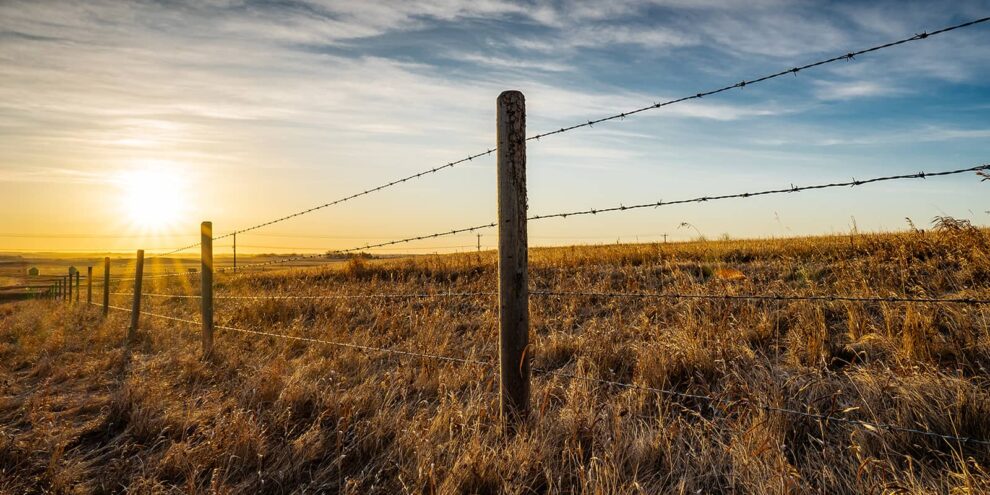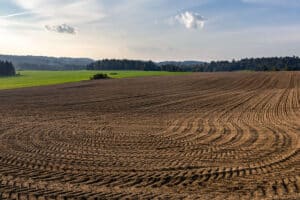It doesn’t matter if you own 80 or 10,000 acres, your property has legally defined property lines. The purpose of property lines is to define where property begins and ends. It’s a simple of way of knowing what belongs to you and what belongs to your neighbor. Because of property lines, and real estate laws in general, we can enjoy and manage our property as we see fit and we can control access from the public. Now more than ever people want security and control. The only way to ensure you have that is to establish property lines and protect them at all cost.
This Land Is My Land, That Land Is Your Land
You’ve heard the old adage “good fences make good neighbors”. That rings true today more than ever. As urban sprawl cuts into once rural areas and consumes acres of rural or recreational land, access to quality hunting land becomes a growing problem for our nations’ outdoors enthusiasts. The result: trespassing has become more prevalent. This has made the need for well-defined property lines a key element of land management. Trespassing is a major problem that can directly impact the value of your land, can limit your own enjoyment of your land, and can even pose a threat to the safety of those who hunt and recreate on your land. Most of the cases of trespassing are intentional and malicious, but occasionally it occurs because the property lines were not properly established via marking paint, posted signs, or fences. As a landowner, it is imperative to do everything in your power to establish visible and defined property lines for everyone to see clearly. You do not want to give a trespasser a leg to stand on in court should the need ever arise. If you have taken the time to mark your property lines, a trespasser cannot plead ignorance as a defense and you will establish an implied mutual understanding with your neighbors.
In order to properly mark your property lines you must first make sure you know where the deeded property lines are. It is highly recommended that you hire a licensed surveyor to make sure there are no discrepancies in any perceived property lines; fences and old paint lines are not good indicators of the property lines described in the legal description. Many disputes between neighboring landowners arise from disagreements as to where your boundaries are located. Sometimes mere feet can result in costly lawsuits, but if you hire a surveyor, much of the burden of accuracy will fall back on him.
Once the surveyor has flagged or temporarily marked the property lines, you need to establish more permanent lines. This can be done by either painting trees on the line, building a fence, or putting posted stakes up. In open areas where trees are not available for marking, fencing may be necessary. Posting property is a great way to let someone know they have entered private land and they might not be welcome. At the very least, posted signs should be placed at all gates or access points and on each corner of your line, and they should be where people can easily see them. Placing a posted sign every 300 yards along a painted boundary line would be good. Again, remember that visibility is important and it is hard to argue a well-established property line.
If your land is in an area where large animals, like livestock or cattle, could end up on your property, barbed wire fencing may be necessary. Even though the responsibility of maintaining fences for livestock really falls back on your neighboring farmer, you may be better off having a fence built than having cows feast on your food plots. If a neighbors’ livestock should happen to wander onto your property, be cordial yet firm. Most farmers will be eager to remedy the problem and have their fences repaired as long as you show some understanding when handling the situation.
Here’s another piece of advice: if you want to prevent the public, or your neighbors, from viewing open areas (such as a food plot) on your property, consider planting “screening cover” to limit visibility. Screening cover can be provided by small trees, brush or tall grass, or tall forbs. Mossy Oak Nativ Nurseries makes a great product under their Nativ Seeds product line that can help form a visual barrier and prevent “night hunting” or the public from being able to see onto your property. Screening cover is referred to as browse and is also important to deer during stress periods, summer and winter.
Fringe Benefit of Well-Marked Borders
Property lines can also double as access roads. Many landowners prefer to have roads that wrap around the perimeter of their property. The main reason for this is because these access roads can provide the most efficient, low-impact travel routes to enjoy your land. Additionally, they add another buffer against trespassing, as foot tracks are more visible in dirt than grass or leaves. Also, the perimeter roads can be used as fire lanes to not only prevent prescribed fires you conduct from getting out of control, but also to prevent fires from adjoining landowners causing costly damage to your property.
The Returns on Well-Marked Borders
When you look at the impact that having properly marked boundaries can have on the resale value of your property, it makes the time, money and effort needed to establish them a drop in the bucket. Buyers want secure investments and if the property has quality gates, well-established fences and/or marked lines, they will feel more at ease that problems such as trespassing and poaching will be avoided. In some cases, the lack thereof can be a dealbreaker for buyers.
A prime example is a tract of land I had listed for sale several years ago. The property was owned by absentee landowners and was as good of a recreational and timber tract as you could hope to find. However, the tract was plagued by trespassers and poaching, due in large part to the landowners doing little to maintain their property lines. As a result, several buyers passed on the property and a “black cloud” developed over the property. Eventually, the landowners were able to sell it but ended up taking a sizable loss on the sale. Since their purchase, the new owners have fixed up the property lines and reached out to their neighbors. Trespassing is is no longer a problem. If that same property was listed for sale today, it would most likely sell at or above market value. You get the point. Establishing access control is very important, right now and down the road.
The above example illustrates why “border control” is a very important component of land management. Keep in mind that you can do whatever you want to the interior of your property, but if you do not protect your borders, all may go for naught. One of the most important aspects of land ownership is placing an emphasis on establishing and maintaining the boundaries of your property. Well-marked boundaries will help ensure your assets are protected.
Article contribution by Mossy Oak Properties. The Mossy Oak Properties land brokerage network was launched in 2003 and has since grown to over 100 franchised brokerages in 30 states throughout the country.
This content may not be used or reproduced in any manner whatsoever, in part or in whole, without written permission of LANDTHINK. Use of this content without permission is a violation of federal copyright law. The articles, posts, comments, opinions and information provided by LANDTHINK are for informational and research purposes only and DOES NOT substitute or coincide with the advice of an attorney, accountant, real estate broker or any other licensed real estate professional. LANDTHINK strongly advises visitors and readers to seek their own professional guidance and advice related to buying, investing in or selling real estate.










Add Comment